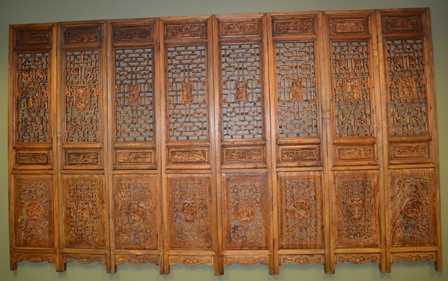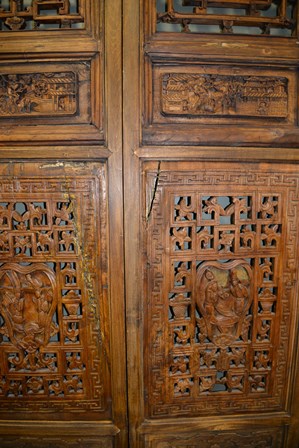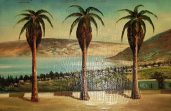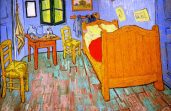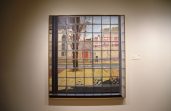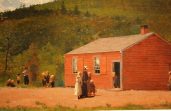What do we treasure?
Recently, I toured the Belz Museum in Memphis Tennessee, which specializes in Asian and Judaica works of art. http://www.belzmuseum.org/ ; the collection was quite fascinating; and you may be sure that I shall be sharing some of the work with you. Prominently displayed, was an intricately carved wood screen, consisting of eight panels from the Qing dynasty, 19th Century, which like so much of the Belz collection drew me in to take a closer look.
As I was admiring the screen, I could not help but notice that it had been repaired – this museum piece was not without flaws.
I continued walking around, swept into the Judaica wing, which was what I had come to see, but unable to forget about the screen. My thoughts began to float back to all of the “imperfect” pieces, which were displayed in museums, all over the world, and how I had actually always taken issue, especially with broken pottery. Should not museums house the impeccable? How did they find value in shards? What did the faded, cracked, or damaged piece have to offer us? Oh my!
I was suddenly embarrassed by my mind. Not only have I studied art and archeology, I am a historian, I know exactly how valuable and telling a piece of a water jug can be; and how reconstructing the jug, even with contemporary pieces can bring not only its functionality to life, but also its beauty, and share with us a portion of the potter’s story. What in the world was I thinking? But why were canvases always pristine and yet sculpture, pottery, jewelry, and other everyday objects valued in whatever state they were found? Art should make us think . . . I kept walking and snapping photographs.
The Judaica wing spoke to my spirit, and I once again chastised myself for not having mastered how to photograph works under glass; but as I continued to the much larger Asian exhibits, with their mammoth size yet intricate carvings and detail, I found myself assessing not only my lack of education in Asian art, but how I view what I think of as damaged.
The beauty of this collection was undeniable, yet there was more than one piece, like at all museums which had been treasured, regardless of what the centuries may have done to it; and as I left the museum and began to walk the streets of Memphis, my mind wondered to a friend whom I love dearly and whose home I deeply admire.
I well remember the first time I stepped into the house, at her husband’s invitation. We were warmly welcomed, and led to the living room, where we sat on the sofa, while she offered us something to drink and passed around trays of clever appetizers. As the conversation progressed, I kept scanning the room, mesmerized by book shelves, which bore titles I too had read, and others I wanted to talk about. I was awash in their art adorned walls, and tried to not be overly obvious, as I stretched my neck, to see into the china cabinet, which housed a beautiful collection of fine crystal and porcelain, while I wondered what lay beyond my vista. Eventually, my dear friend would share her home with me, and regale me with the stories of when and where or from whom, each piece of her home had been acquired. It was through her stories that I met the people in her life, which were no longer living, anywhere except on her walls, table tops, and the book shelves in her house and of course her heart.
As the years passed, her stories grew in detail, as she would tell me more about the particular trip where something had been purchased, or how it made her feel when she saw it, or how much she missed the person whom had given her some specific treasure. Her words reflected the beauty and love, which she felt and I was honored to share in, through her words. It was also how I viewed my own treasures – the stories were as important as the pieces – I valued an object because it had been given to me by my Mother or a friend, or found on a trip or in the trash, and in the retelling of the story, the person, the trip, the moment came back to life. I was once again sitting on a stone wall, discussing not only the price for the demitasse spoons a woman perhaps not fifty who looked at least seventy, with a kerchief tied around her head, and sorrow filled eyes, was trying to sell me, but what the fall of the Soviet Union had meant to her and Bulgarians in general. I love those little silver spoons, whose pattern is unevenly worn, perhaps from polishing or simply from being snuggly held, as they stirred countless cups of coffee in Bulgaria. Did I question if five dollars was too much for such worn spoons, shame on me if I did.
It began to rain and I ducked into a coffee shop, searching for succor and continued to think about my friend and her museum like house. I remembered having complemented a particular painting, not that long ago, and her describing how the painting had been damaged in a storm, and had had to be sent to an art restorer, who had done an excellent job of preserving the canvas. It was after that conversation, that I noticed how many of her treasures were in what someone else might consider less than perfect condition; though I had certainly never seen them as anything other than insights into her life.
I knew from the smiles, which would cross her face and then the bit of melancholy that would follow, that she did not differentiate between the chipped, cracked, and glued back together items and those that were in perfect condition, for her, the appreciation of the gems which surrounded her, had nothing to do with their resale value, and everything to do with the memories which they warmed her with.
I remember going home that night, after the story about the painting, and thinking about how my Mother never liked things once they were damaged. If a cup chipped or the handle broke off, she would discard it; instilling in me a deep respect for bubble wrap! If a piece from a set of china cracked, I never glued it back together, I would hit the second hand stores or eBay, and look for a replacement, but mostly, I took incredibly good care of my things, making sure that they did not break, trying to be a good steward.
Was my Mother right? I do not know, but she was not wrong. I certainly do not want to drink out of a chipped cup; but what about a piece of furniture that has been scratched? Is it worth keeping? Do we try to fix it, place a platter over the scratch, or donate it to the Goodwill? Or can we simply embrace the bumps and bruises, it acquired along the way?
It was Valentine’s Day, and I was surrounded by celebratory couples, I had to wonder about their bumps and bruises. Do we treasure the people in our life, like we do the things in our life? Do we throw away people because they are broken or damaged? Do we send the people we claim to love out to be restored? Do we glue them together again; add a support to their back, or a fresh coat of paint to them, when they are shattered by the storms of life? Is it easier to mend an ancient carpet than an ancient friendship? I suppose it is a question of value. Do we value the good memories more than the bad? Does the print so perfectly capture that trip to Paris, that the water stains do not matter? Ah, it seems easier to forgive a water stain than say a betrayal or sometimes even an unintended offense by someone we love.
After dinner, we stroll through the grand hotel, which we are staying at, and it fills me with nostalgia for an era I of course never knew. The room we are staying in is not as grand as the lobby, but it does not matter. I overlook the imperfections and instead feast my eyes on the beauty that still stands – and I am once again convicted, but this time it is my heart and not my mind which admonition’s me in a roaring whisper: I so need to strive to treat people as if they were treasured museum pieces – That Is All For Now.


